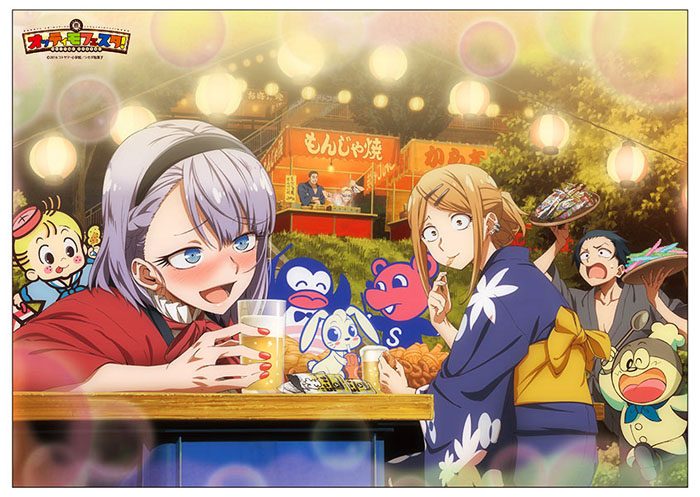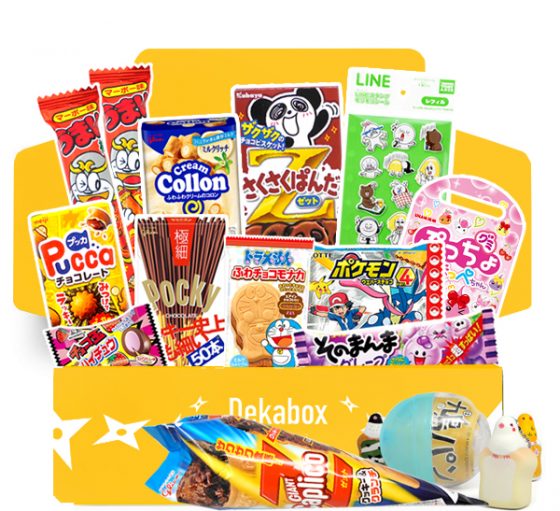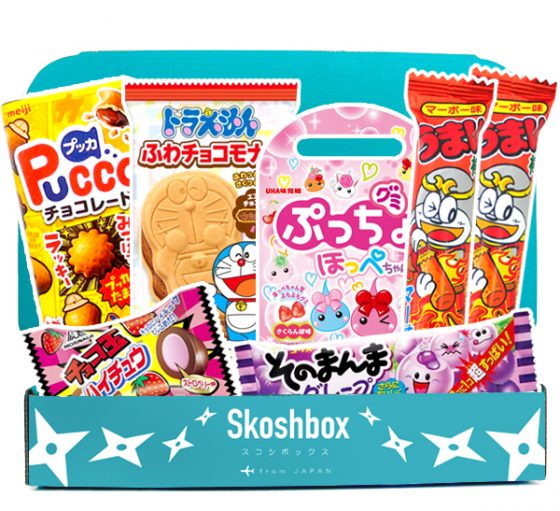
Dagashi Kashi was a clever slice-of-life shounen comedy about the ins and outs of Japanese snacks. Even though you may have enjoyed the jokes revolving around sexual innuendo, it’s easy to feel a little lost without that sense of nostalgia for the actual treats featured in each episode. Lucky for you, we’re here to fill you in.
When you really think about it, those snacks you ate as a kid really are the epicenter of childhood. One of Dagashi Kashi’s strong points is that it fills in viewers with a lot of little trivia about these snacks. It’s a delightfully nostalgic for Japanese viewers, and the show also reveals possible unknown facts about the tasty things that filled their childhoods. This same principle is the basis of the U.S. television series Unwrapped on the Food Network. We eat food, and we want to know all about it.
Since a lot of us around the world didn’t grow up with Japanese snacks, let’s take this moment to appreciate some of Dagashi Kashi’s finer products—many of which you can actually find outside of Japan.
10. Baby Star Ramen
Usually we are getting knowledge straight from Hotaru, but every once in a while Kokonotsu flexes his snack trivia muscles, as he does in Episode 5. Kokonotsu’s father is painfully trying to host a streaming video channel but failing miserably. Kokonotsu interjects and lays out all the great parts of Baby Star Ramen, a snack made from the leftovers of dried ramen noodles—yes, instant ramen. It was one of those accidental discoveries during the development of instant ramen. Unlike instant ramen, though, you don’t add water. You just eat them straight from the bag. Surprisingly munch-worthy, children like chomping on these salty swiggles, and adults enjoy eating them as a side to alcohol. Similar to corn flakes, Baby Star Ramen is also a good topping on various Japanese dishes, including monjayaki, as mentioned in Dagashi Kashi’s festival episode.
9. Suppai Grape
This is Suppai Grape ni Goyojin, which translates to Watch Out for the Sour Grape. The name of this fun candy in Episode 5 might be a little disheartening, but Japanese people would have a few fond memories of the Suppai Grape. Out of three little candy balls in each package, one little guy is extremely sour. You may never get a real chance to play Russian roulette, but having a Suppai showdown with your friends can bring that same kind of excitement. Unfortunately for Hotaru, her luck is notoriously bad, and she gets hit right in the mouth with a sour attack, while Kokonotsu and Tou enjoy sweet, sweet victory.
You may be thinking that Suppai Grape seems like a waste of money. Who would want to take the risk of dying by sour death? That’s part of the fun, my friends. You could follow Hotaru’s lead and even raise the stakes by betting other conditions for the sourpuss loser. Still, losing isn’t the worst thing to happen, because the more you lose, the sweeter victory tastes! (Full disclaimer: The author of this article has had at least ten Suppai showdowns with over half of them losing in sour-filled defeat. The author swears that she does not have gambling problem.)
8. Un Choco
What’s a comedy program without a poop joke? Enter Un Choco. Little grape candy-coated chocolate balls come in a cute little animal package that catches Saya’s eye. Still, the name sounds a little uncomfortable to the young girl, because in Japanese, it sounds a lot like “poop chocolate.” Completely ignoring Saya’s uneasiness, Hotaru even goes so far to say that they will have a “poop party.” Just when you think Saya can’t take it anymore, we find that the little tasty balls make an exit from their cute animal holders in the only way that you would expect: out the backdoor.
In all seriousness, though, the chocolates are actually tasty with a little zing of grape-ness. Un Choco totally deserves the praise Hotaru gives it as dagashi’s “new hero.” Kids tend to like the cute animals and further enjoy the toilet humor that arises naturally from eating them. Did we mention the packaging is super cute?
7. Morinaga Milk Caramel
Milk Caramels have been sold by the company Morinaga since 1913. The snack became a hit after the company started to sell them in pocket-sized packages so you could take them everywhere. In retro-fabulous fashion, the candies are still sold in almost identical packaging to their first pocket-sized iteration. Kokonotsu even fills us in that the caramels were advertised as a way for smokers to kick the tobacco habit.
Now, the caramels come in a number of flavors, including coconut, a shout-out to Kokonotsu’s nickname, which sounds awfully similar to the Japanese pronunciation of the word “coconuts.” Regardless of what you think about semi-soft caramel cubes, the longevity of this candy attests to its tastiness. If you want some more Westernized trivia, Morinaga has the rights to import and sell Wether’s Originals in Japan. Yes, Morinaga has cornered the caramel-flavored feels machine in Japan.
6. Glico Caramels
At least, Morinaga tried to corner the caramel market in Japan. Glico Caramels are most famous for having their logo become a landmark in Osaka, Japan. The logo, also featured on the box, is of a man in a victory pose, possibly after winning a race fueled by caramels. As mentioned with painstakingly calculative detail in the actual episode, one little caramel should be able to fuel a 300-meter run, given that the person is of a certain height and weight and runs the distance in 1.88 minutes. Each little piece has 15.4 Calories. These numbers are Japanese accurate, so you probably shouldn’t question them too much. Still, we’re not really sure if we would want to depend on caramel candies to run, but it could happen, as Hotaru and Kokonotsu gracefully demonstrate.
Glico also makes Pocky, which is a more modern snack favorite compared with the original caramel candy. Glico, along with Morinaga, are Japanese confectionary powerhouses, so it’s no wonder that they would get their own features in Dagashi Kashi.
5. Butamen
Butamen is cup ramen for kids! Hotaru drops some knowledge the hard way, letting her friends Kokonotsu and Tou know that the best way to beat the heat is with a piping hot cup of ramen. Now, this might seem strange, but fighting fire with fire isn’t a horrible idea. After finishing off a too hot treat in the middle of summer, Hotaru implies that you can build a stronger tolerance to heat. Kokonotsu questions Hotaru’s sudden fervor for being able to withstand desert temperatures, but Tou sticks around for the nosebleeds.
Whether or not you want to try to increase your heat tolerance, cup ramen is pretty awesome, and Butamen comes in a miniature snack-size for those days when you just want a little ramen and not a whole bowl. Butamen comes in a number of flavors that you would expect from cup ramen, but its most famous flavor is pork bone soup and considered the safe bet for kids in Japan when they desperately want some cheap instant ramen.
4. Sakuma Drops
You might recognize the iconic tin can of Sakuma Drops from their appearance in Ghibli’s classic Grave of Fireflies. Sorry about bringing up that sad memory, but we wanted to illustrate that these fruit candies have been around for a long time. The can design changes from time to time, and many have collected them throughout the years. The candies themselves are pretty yummy, even the mint and chocolate ones!
After escaping the rain, Kokonotsu and Hotaru are stuck taking shelter at a bus stop. Hotaru carries around the tin just in case she gets a sudden craving for something sweet, but she has some trouble opening the sturdy tin can. Kokonotsu shows her the easiest way is to use a coin to lift the lid off. Hotaru then eggs Kokonotsu on to try the mint flavor. Let’s just say, even if your OTP is Kokonotsu x Saya, this moment between Kokonotsu and Hotaru is pretty cute.
3. Wata-pachi
Wata-pachi is so alluring that Hotaru wants to eat the sweet and fun candy even though she’s suffering from a mouth ulcer. Wata-pachi looks like cotton candy, but it’s hiding popping candies on the inside. The popping candies are similar to Pop Rocks in the States, but combining popping candy with cotton candy is pretty ingenious. For the best experience, Hotaru takes the whole piece of cotton candy with one bite, and we get a closer look at the drama-filled, ephemeral lives of the popping candy inside Hotaru’s mouth.
Despite a painful and tragic end for our little popping buddies, wata-pachi is a surprise party in your mouth. You’re not exactly sure when it’s going to show up hidden inside the tasty cotton candy, but when the cotton dissolves away, you’re left with explosions of flavor and popping that’s pretty painful if you have a mouth ulcer, but just good fun otherwise. In this list, wata-patchi by far has the most interesting finishing “taste” of them all.
2. Ramune
Ramune is a summer time classic, and as the series takes place during the summer months, we see the characters drinking Ramune out of its iconic blue bottle pretty often. It even appears in the opening and ending themes. Ramune is a Japanese re-working of the word “lemonade,” but it is more accurately a lemon-lime soda. The cod-neck bottles are sealed with a marble that is pushed down into the neck to open. The glass bottle is now considered a symbol of summer and is regularly sold at summer festivals.
In the 11th episode, Hotaru offers to share her Ramune with Kokonotsu as they wait for a train. Facing a possible indirect kiss situation, Kokonotsu nervously spits out the trivia that the taste of Ramune is based on lemonade that Commodore Matthew Perry brought to Japan in 1853. In order to one-up Kokonotsu, Hotaru unleashes a very inaccurate “Drunk History” rendition of Commodore Perry’s first visit to Japan. Somehow that story concludes that the cod-neck bottle would lead to the opening of Japan. Hotaru’s love of snacks has, unfortunately, skewed her whole vision of history. Please don’t trust her on this one.
1. Umaibou
Umaibou is a staple of Japanese dagashi stores, and Hotaru even christens the snack as “King of Dagashi.” We’re not about to argue with the Dagashi Queen, so we’ll just go along with Hotaru on this one. In her surprising first meeting with Kokonotsu, Hotaru demands that Kokonotsu create an Umaibou combination, because the snack comes in so many different flavors. There are, of course, a lot of famous combinations of Umaibou that aren’t normally eaten together, including pizza x natto and sugar rusk x natto, and basically anything x natto. To meet Hotaru’s challenge, Kokonotsu makes an “Italian Set” out of pizza x onion salad x corn potage flavors. Most importantly, in this scene, we get our first taste of the kind of humor to expect in Dagashi Kashi: a little suggestive, slightly otaku, and wonderfully ridiculous.
Umaibou is an over-sized corn puff that will remind you of Cheetos or cheese puffs. Although cheese is a popular flavor, there are a lot more to try, including limited regional flavors. Interestingly, the flavoring process isn’t just throwing powder in the mix. Using different methods, Umaibou also brings different textures with certain flavors, such as takoyaki and sugar rusk. As you can guess by the individualized packaging, Umaibou is very inexpensive, so many Japanese people ate it as a snack when they were children. Not to mention, the Doraemon-like character of Umaibou is so cute that the snack just calls out to you from the store shelf.
We came for Hotaru, but we stayed for the snacks.
There you have it: the best treats in Dagashi Kashi. These and other Japanese snacks can easily be seen in a number of anime. Besides the strong presence of Sakuma Drops in Grave of Fireflies, you’ll see Gari Gari Kun popsicles (Dagashi Kashi Episode 1) in the tearjerker Anohana. As for anime that’s not incredibly sad, Gari Gari Kun also appears in Kuroko’s Basketball, along with Umaibou and more, thanks to Murisakabara Atsushi’s snacking obsession. As for this season, Edogawa Ranpo becomes enamored by the marble in his Ramune bottle in the fifth episode of Bungo Stray Dogs. As many of these snacks are often associated with childhood, they are used in anime to show a childlike aspect to a character, or to connect characters to their childhood memories.
We’re lucky to have Dagashi Kashi to satisfy our otaku thirst for info on these tasty icons. Your diet might be ruined, but at least you got some good tips for your next snacking adventure. If you can get your hands on some of these, you should definitely give them a try and learn why our favorite characters can’t help but gobble them up. Who knows? You may even become completely obsessed, just like our reigning Dagashi Queen Hotaru. Which one of these snacks do you want to try next?
[Contest Closed] Thanks for Participating!
Introduction:
This time, we are doing a food giveaway! What kind of food you ask? Why Japanese snacks of course! We do the eat like your anime favorites articles and now we are bringing you some of the best that appeared in hit winter anime, Dagashi Kashi. TOM has recently launched a monthly subscription service in the US that includes Japanese snacks just like those that have appeared in Dagashi Kashi and more. There are three options that you can read about here.
Terms and Rules
NOTE:
Prizes:
1 megabox every month for a YEAR! That’s right, you get a full free year of the BEST box that Tokyo Otaku Mode has to offer! Each month a Megabox will be delivered to your house!

2 Dekaboxes. Two people will win 1 dekabox each.

4 Skoshboxes. Four people will win 1 skoshbox each.

How to Enter:
Recommended Post


